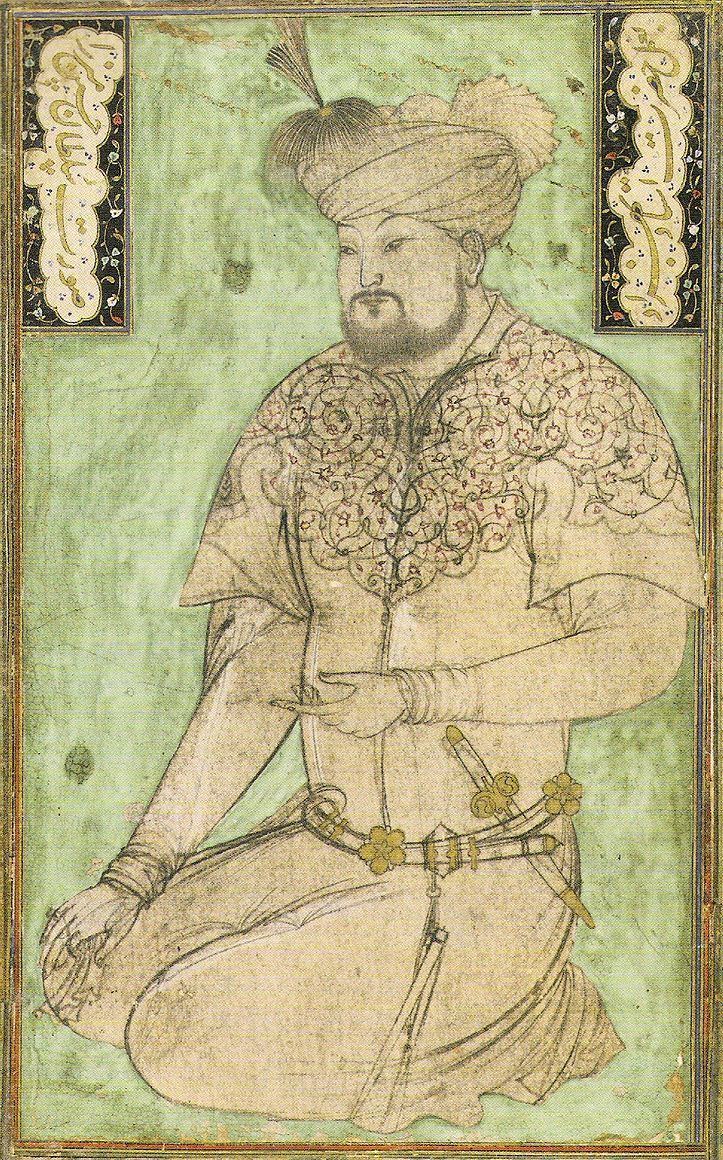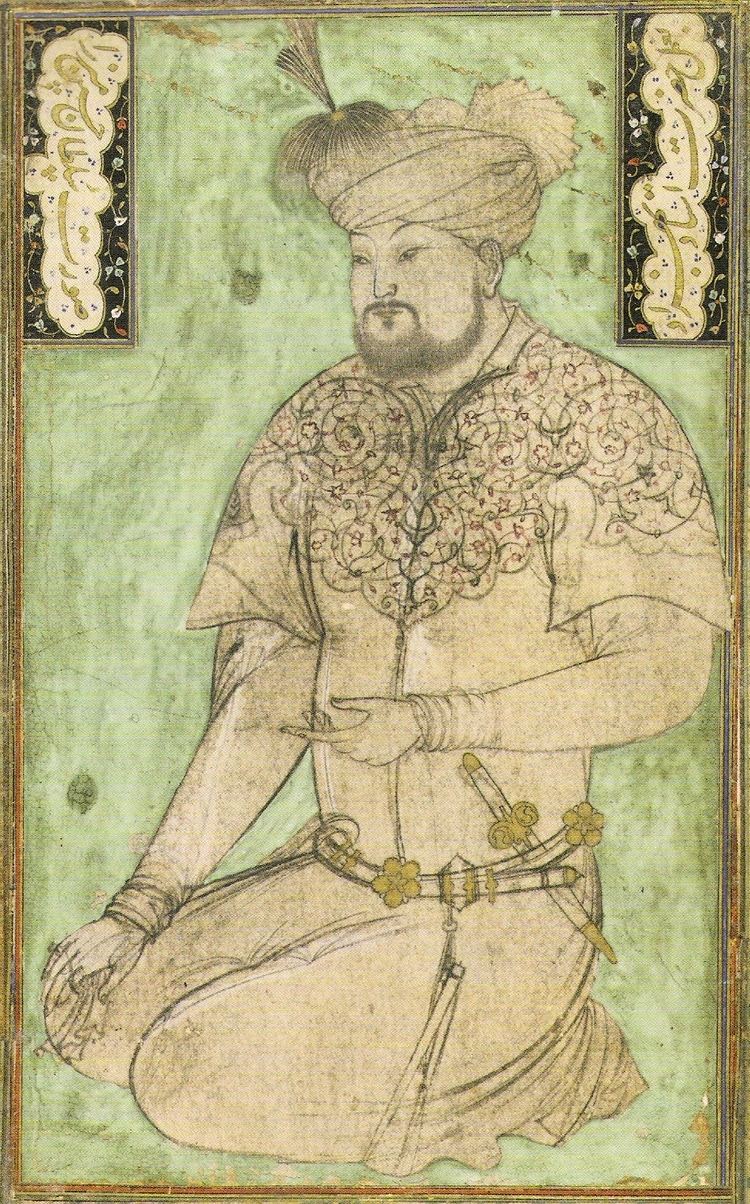Reign 1469 – 1506 Role Ruler Father Mansur Mirza House Timurid dynasty | Mother Firoza Sultan Begum Name Sultan Mirza Predecessor Abu Sa'id Mirza | |
 | ||
Successor Badi' al-Zaman Mirza & Muzaffar Husayn Mirza Spouse Bega Sultan Begum
Juli (Chuli) Begum
Shahar Banu Begum
Payanda Sultan Begum
Khadija Sultan Begum
Afak Begum
Zobeida Aghacha
Papa Aghacha
Latif Sultan Aghacha
Mangeli Bibi Aghacha
Begi Sultan Aghacha Issue Badi' al-Zaman Mirza
Muzaffar Husayn Mirza
Shah Gharib Mirza
Abul Hassan Mirza
Muhammad Muhsin Mirza
Abu Tarab Mirza
Muhammad Husayn Mirza
Feridun Husayn Mirza
Haider Mirza
Muhammad Maasum Mirza
Farrukh Husayn Mirza
Ibrahim Husayn Mirza
Ibn Husayn Mirza
Muhammad Qasim Mirza
Sultanim Begum
Ak Begum
Kechek Begum
Bega Begum
Agha Begum
Fatima Sultan Begum
Nizhad Sultan Begum
Sa'adat Bakht Begum
Aisha Sultan Begum
Bairan Sultan Begum
Munawar Sultan Begum Died May 4, 1506, Herat, Afghanistan Children Badi' al-Zaman Mirza, Abul Hassan Mirza | ||
Place of burial Herat, Afghanistan | ||
Sultan Husayn Mirza Bayqara (Persian: حسین بایقرا / Husayn Bāyqarā) was born in Herat in June–July 1438 C.E. to Ghiyas ud-din Mansur Mirza son of Bayqarah Mirza I son of Umar Shaikh Mirza I son of Amir Timur Beg Gurkani. He was the Timurid ruler of Herat from 1469 until May 4, 1506, with a brief interruption in 1470.
Contents
- Early Life and Distinguished Lineage
- Period of Anarchy in Khurasan
- In Merv and Khwarazm
- Timurid Kara Koyunlu Conflict
- Sultan Husayn Mirza Bayqarah vs Abu Said Mirza
- Becomes King of Khurasan
- Conflict with Ak Koyunlu and Yadgar Muhammad Mirza
- Administration
- Uzbek threat
- Marriages and progeny
- References

Early Life and Distinguished Lineage
Ghiyas ud-din Mansur Mirza of the Barlas tribe was married to Firoza Sultan Begum daughter of Sultan Husayn son of Muhammad Beg son of Amir Musa of the powerful Tayichiud tribe. To them were born two sons named Bayqara Mirza II and Sultan Husayn Mirza as well as two daughters. Sultan Husayn Mirza in addition to Timurid and Genghis Khanid lines also claimed descent in the ninth generation from Khwaja Abdullah Ansari of Herat also known as Pir-e-Herat (Sage of Herat). His father died when he was around seven or eight years of age. Given that his father was not a noteworthy personality in the Timurid family he took the name Sultan Husayn Mirza Bayqarah after his more illustrious grandfather. After consulting with his mother he entered the service of his older cousin Mirza Abul-Qasim Babur bin Baysonqor, ruler of Herat, in 1452. Mirza Abul-Qasim Babur was not the best ruler. He mismanaged his territory and went into battle against Abu Sa'id Mirza, the Timurid ruler of Samarkand. Sultan Husayn Mirza not happy with his employment tried to go over to Abu Sa'id Mirza by meeting with him. Although Abu Sa'id was inclined to take him into his service, a rebellion on part of Sultan Husayn Mirza's relative, Sultan Awais Mirza son of Muhammad Mirza son of Bayqarah Mirza, induced Abu Sa'id to arrest Sultan Husayn Mirza and other relatives as a precaution. Eventually on the plea of his mother, Firoza Begum, he was freed and he rejoined Mirza Abul-Qasim Babur bin Baysonqor till Baburs' death two years later.
Period of Anarchy in Khurasan
Following Babur's death in 1457 a period of anarchy ensued in Khurasan. Economic instability and lack of central authority with frequent regime changes invited the invasion of Khurasan by the Timurid ruler of Samarkand, Abu Sa'id Mirza who occupied Herat on July 19, 1457. But Abu Sa'id Mirza immediately abandoned the city in order to deal with troubles at home. Next came the invasion of Kara Koyunlu leader Muzaffar-al-Din Jahan Shah ibn Yusuf who took Mazandaran. During this chaotic time Khurasan was divided into many territories;
In Merv and Khwarazm
Sultan Husayn Mirza unable to compete with these rivals adopted the life of a mercenary and joined Sultan Sanjar Mirza of Merv who married him to his daughter Beqa Sultan Begum. To them was born Badi' al-Zaman Mirza. Sultan Sanjar Mirza and Sultan Husayn Mirza got along well, but in June/July 1457 when Sanjar appointed Husayn in charge of the city while he was absent, Husayn tried to take power after he suspected the chief dignitary Hasan Arlat of plotting to kill him. Amirs loyal to Sanjar revolted and the attempt failed. Sultan Husayn Mirza was forced to escape with just 5 horsemen. But outside the city he was joined by the head of security of trade caravans of Iranji sector, named Hasan Charkas and his 200 men. This would become Sultan Husayn Mirza's first mercenary force. To solidify this new relationship he married Hasan Charkas' daughter named Afāk Begum. He was chased by Sanjar Mirza to Karakum Desert. He was continuously pursued by Sanjar till he was forced to march towards Khwarazm where he remained between the deserts of Marv and Khiva.
Timurid-Kara Koyunlu Conflict
Recognizing the weakness of Timurid authority in Herat, Jahan Shah of Kara Koyunlu invaded & took the city on June 28, 1458, which was now occupied by Ibrahim Mirza's father Ala-ud-Daulah Mirza bin Baysonqor. But Abu Sa'id Mirza could not tolerate this and after negotiations Jahan Shah decided to return territorial demarcation to Shahrukh Mirza's times. Thus, Khurasan, Mazandaran and Jurjan were returned to the Timurids and Abu Sa'id Mirza returned and took Herat a second time on December 22, 1458.
Sultan Husayn Mirza Bayqarah vs. Abu Sa'id Mirza
Sultan Husayn Mirza by now had mustered a force of 1,000 men and had taken Jurjan on October 19, 1458 from Kara Koyunlu. Sultan Husayn Mirza was just 20 years old. Abu Sa'id Mirza invaded Jurjan which Sultan Husayn Mirza hastily abandoned and fled towards Khwarazm again. Abu Sa'id Mirza appointed his son Sultan Mahmud Mirza as Jurjan's governor. When Sultan Husayn Mirza learned that Abu Sa'id Mirza had left Herat to crush the rebellion of his relative Muhammad Juki, he attacked Jurjan again and at the Battle of Jauzi Wali in May 1461 he defeated Sultan Mahmud Mirza and appointed Abdal-Rahman Arghun the territory's governor. However, he could not follow up this victory when he besieged Herat from August–October 1461. Abu Sa'id Mirza returned and Sultan Husayn Mirza again fled towards Khwarazm from where he began making pillaging raids into Khurasan; these raids were conducted in earnest starting in 1464. Seeking to protect himself against Abu Sa'id, he requested the help of the Uzbeks. But that help never came since Abul-Khayr Khan, the Uzbek leader died in 1468. This period of 8 to 10 years was the worst in Sultan Husayn Mirza's life. He wandered from one place to the next at times in dire straits.
Becomes King of Khurasan
When Abu Sa'id Mirza went to invade Ak Koyunlu he was defeated at the Battle of Qarabagh and caught. Uzun Hasan handed him over to the 19-year-old Timurid of Shahrukh Mirza's descent named Yadgar Muhammad Mirza who executed Abu Sa'id Mirza. Upon Abu Sa'ids death, the Timurid Empire collapsed. Taking advantage of Abu Sa'id Mirza's absence Sultan Husayn Mirza Bayqarah had again entered Khurasan and besieged Herat which he finally captured on March 24, 1469. Thus he became the Timurid ruler of Khurasan. Although the sons of the late Abu Sa'id Mirza went towards Khurasan but they turned back when they learned that not only had Husayn consolidated his control over Herat but the defeated army of their father had joined Husayn Mirza.
Conflict with Ak Koyunlu and Yadgar Muhammad Mirza
Meanwhile, Uzun Hasan of the Ak Koyunlu (White Sheep) sent his protege, Yadgar Muhammad Mirza, to conquer Khurasan. Husayn defeated Yadgar at the Battle of Chenaran (September 15, 1469), but the latter was sent reinforcements. Uzun Hasan demanded that Husayn hand over various Black Sheep officials who had fled to Herat, a demand which Husayn refused. Yadgar therefore continued into Khurasan, and Husayn was unable to match his forces due to mass desertions. He ended up fleeing Herat, which was occupied on July 7, 1470. Six weeks later, however, Husayn reoccupied the city, after raising a fresh force and defeating the sons of Abu Sa'id who were attempting to advance into Khurasan. He captured Yadgar and executed him.
Husayn's empire was now secure. The White Sheep made no further attempts against him, and the Timurids in Transoxiana were too weakened by internal conflicts to advance into his territory. His boundary with the White Sheep started on the southern edge of the Caspian Sea, running south, then east across the north of the Dasht-e Lut, ending at Lake Hamun. His border with the Timurids was the Oxus River. He more or less respected both borders, refusing to cross north in an attempt to capture Transoxiana from the northern Miranid Timurids. He was probably aware of the Uzbek threat to the region, and was wise enough not to pursue a border with this dangerous tribal people.
Administration
Husayn was viewed as "a good king, a lover of peace and justice", and he built numerous structures including a famous school; however, he was sick with a palsy for twenty years of his reign. He was forced to deal with several revolts and incursions. In 1490 the brother of Husayn's son Ibrahim Husain's guardian, Darvish 'Ali, conspired with Sultan Mahmud, who by that time ruled in Hisar. Mahmud moved against Balkh, which Ibrahim resided in, forcing Husayn to mobilize against him. Some years later, Husayn transferred his eldest son, Badi' al-Zaman, from Astarabad (renamed Gorgan in 1937) to Balkh, but Badi' revolted when his son Muhammed Mu'min was denied rule in Astarabad. Husayn defeated both Muhammed, whom he executed, and Badi', whom he reconciled with. The truce fell apart afterwards, however, and in 1499 Badi' besieged Herat.
Uzbek threat
In 1501 the Uzbeks conquered Transoxiana for good from the Timurid Babur. Under Muhammad Shaybani, the Uzbeks could now threaten Khurasan. Suffering from the effects of advanced age, Husayn made no move against them, even after Babur advised him to act. The Uzbeks began conducting raids into Khurasan. Finally changing his mind, he began to march against them but died in 1506 just after beginning his advance. The inheritance of his empire was disputed between his sons Badi' and Muzaffar Husain. Babur, who had begun an expedition in support of Husayn, noted the infighting between the brothers, decided the area was impossible to defend and retreated. The next year, Muhammad Shaybani conquered Herat and caused Husayn's successors to flee, putting an end to Timurid rule in Khurasan.
Marriages and progeny
He had twelve wives:
- Bega Sultan Begum, daughter of Sanjar Mirza of Merv;
- Chuli Tulak Begum, daughter of one of the chiefs of the Azaks;
- Shahar Banu Begum, daughter of Sultan Abu Sa'id Mirza;
- Payanda Sultan Begum, another daughter of Sultan Abu Sa'id Mirza;
- Khadija Begi Agha, daughter of Amir Muhammad Sarik bin Amir Muhammad Khawaja;
- Zainab Sultan Begum, daughter of Amir Taj-al-din Hasan bin Nizam-al-din Charkas;
- Afak Begi Begum, another daughter of Amir Taj-al-din Hasan bin Nizam-al-din Charkas;
- Zobeida Sultan Aghacha, daughter of Hasan bin Hussain Sheikh Taimur, of the race of the Shaban Sultans;
- Latifa Sultan Aghacha, daughter of Amir Sultan Husayn Chaharshanba and a relative of Jahan Shah;
- Mangeli Bi Aghacha, an Uzbek lady, and a slave girl of Shahar Banu Begum;
- Baba Aghacha, daughter of Khawaja Muhammad Ataka, and foster sister of Zainab Sultan and Afak Begi Begum;
- Begi Sultan Aghacha, who had not bore any children to the Mirza
He had fourteen sons and eleven daughters who lived:
